Ready to bake but don’t have the right pan? Or need to scale a recipe for a different pan size? Knowing the volume capacity of baking pans will help you figure out a substitute. Check these charts for the most common sizes of pans, and also learn how to calculate the volume capacity of any baking pan!
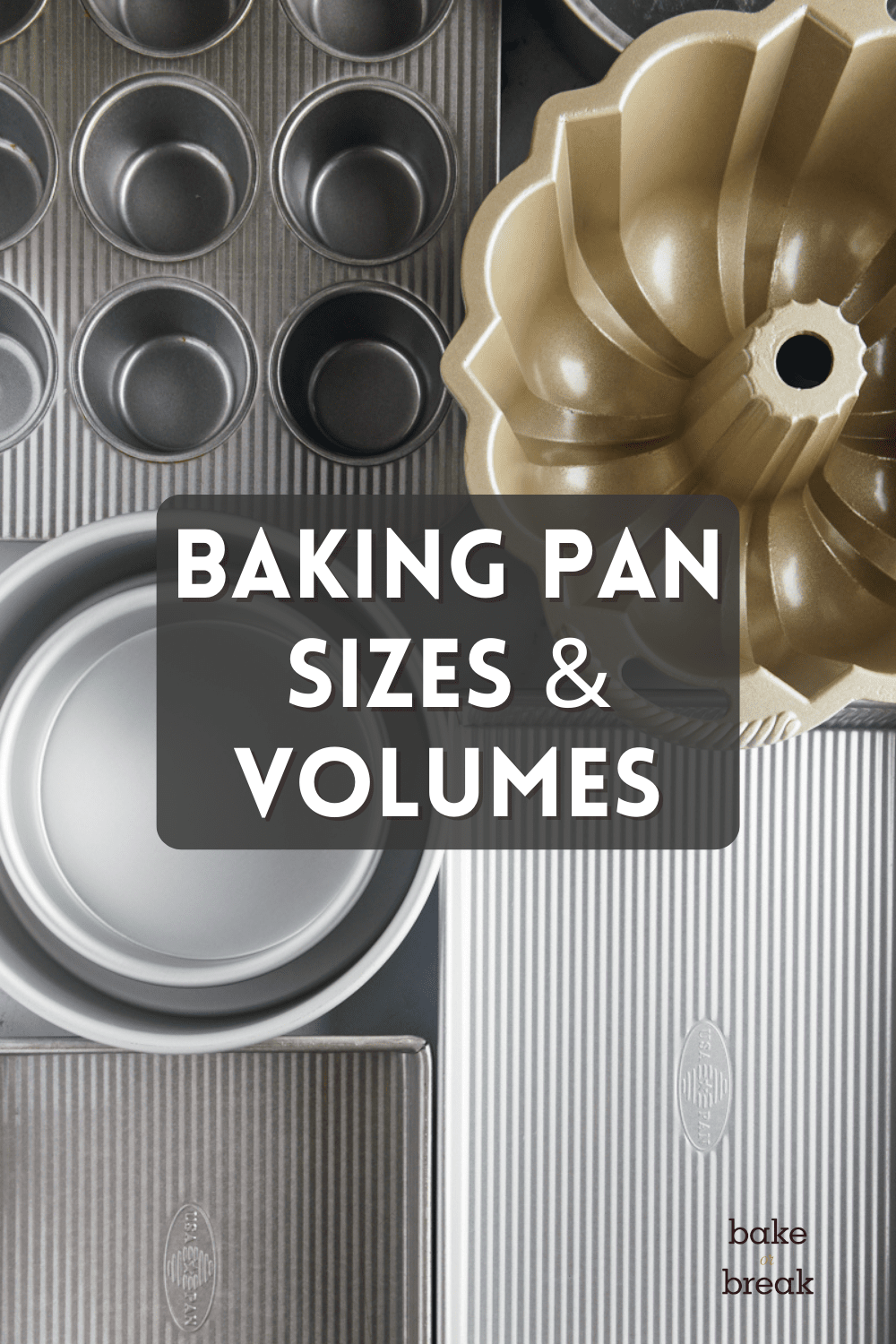
Common Baking Pan Sizes and Capacities
I think we’ve all at one time or another been excited to make a recipe but realized that you didn’t have the right pan. Sometimes switching pans is easy, and other times not so much.
It’s all about the capacity of the pan. And here you’ll find the sizes and volume capacities of common baking pans so you can determine which pan will work best for your recipe. You can also use this information to help find the right pan when scaling a recipe.
I’m also sharing how to figure the capacity of any pan. We’ll start with the math approach, and then you’ll find an alternative method that doesn’t require an equation!
How to Measure a Baking Pan
When measuring the width, length, and depth of a baking pan, measure the inside of the pan. Even if your pan doesn’t have a wide lip, the material of the pan itself adds thickness. And be sure to measure the depth of a pan with the ruler straight up and down, even if the pan has slanted sides.
You may find that some of your pans list dimensions that are measured from the outside of the pan. That’s not uncommon, so just keep that in mind if what you measure doesn’t quite add up to the listed dimensions.
How to Determine a Baking Pan’s Capacity
If you’re unsure of a pan’s volume capacity, it’s easy to calculate that using a simple ruler and some basic math. Of course, if you’re not a math nerd like I am, you can just skip ahead to the tables below to find the dimensions and volumes of common baking pans.
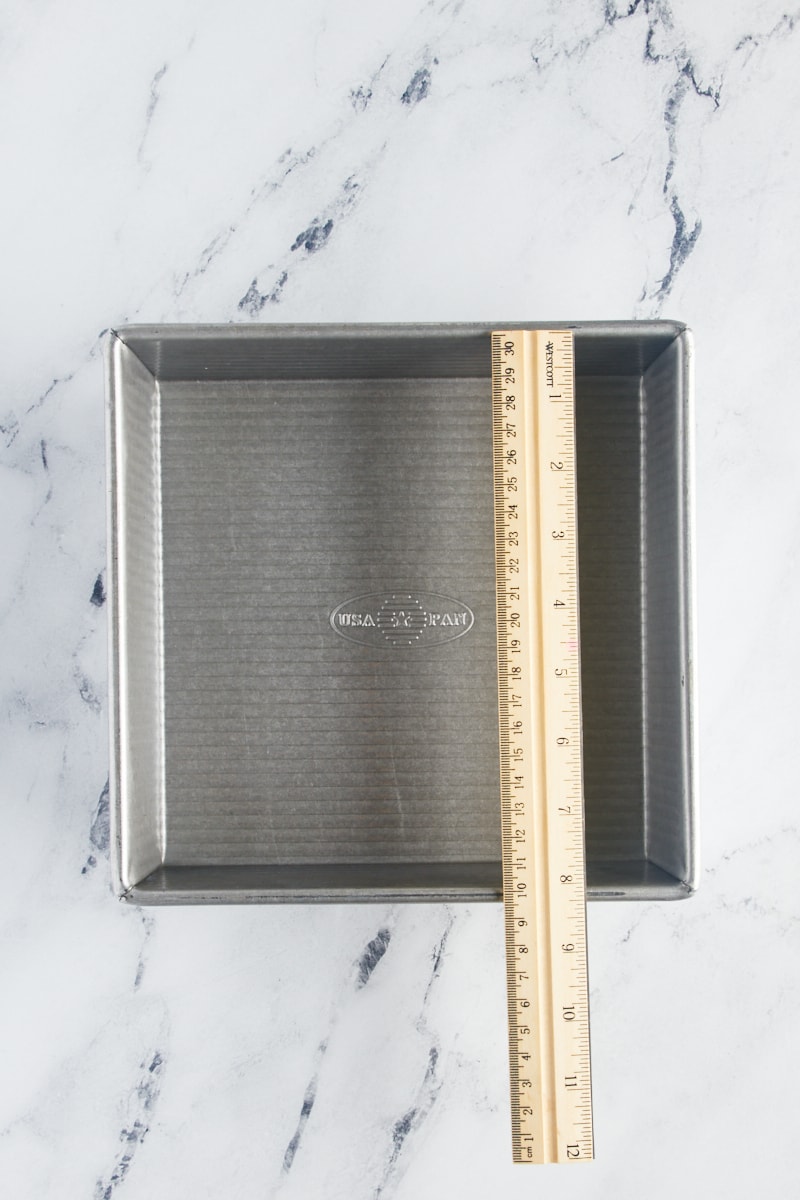
Calculating the Capacity of Rectangular Pans
For square or rectangular pans, you have a couple of options. You can simply multiply the width by the length to get the area of the pan. (You remember geometry, right?) This works well if your pans are of the same depth. I use this a lot in my kitchen, especially to compare pans of similar depths. To give you an example, a 9″ x 13″ pan has an area of 117 square inches, and an 8″ x 8″ pan has an area of 64 square inches. For most purposes, that’s close enough to use the smaller pan as half of the larger pan.
For more accurate measurements, you also want to multiply by the depth to get the volume of the pan. From there, you’ll get a measurement in cubic inches (or cubic centimeters if you’re using metric measurements). There’s a bit of rounding down here, but an easy on-the-fly math is that a cubic inch equals 0.5 fluid ounces. From there you can determine the pan’s volume capacity. Going back to our 8″ x 8″ pan and multiplying the 2″ depth as well, you’ll find that it has a volume of 128 cubic inches. Convert that to fluid ounces by multiplying by 0.5, and you’ll get 64 fluid ounces, which is 8 cups.
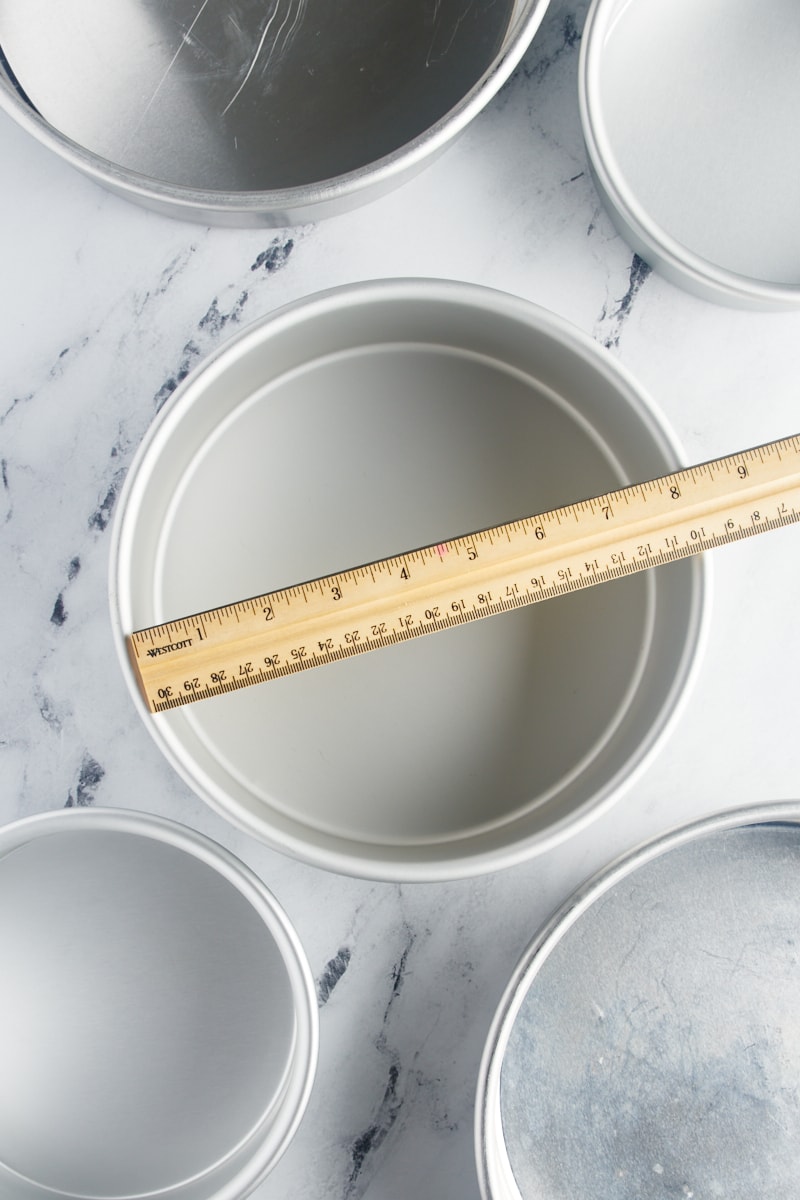
Calculating the Capacity of Round Pans
Similar to rectangular pans, often the area of round pans is enough to determine if you can change the size of your pan for a recipe.
To calculate the area of a round pan, multiply the radius by itself and also by pi. For those who need a refresher, the radius is half the diameter. Measure the width of the inside of the pan at its widest points (that’s the diameter), and divide that by 2 to get the radius. Multiply that number by itself (squaring it) and then multiply by 3.14 (pi). As an example, the radius of a 9″ round pan is 4.5 inches. Multiplying 4.5 (the radius) times 4.5 (the radius again) times 3.14 (pi) gives you roughly 64 square inches. From our above calculation for the area of an 8″ x 8″ square pan, you’ll see that these two pans have the same area. If your pans have the appropriate depth, you’re all set!
To determine the volume of a round pan, the depth must be put into the equation as well. Simply multiply that measurement along with the squared diameter and pi. For a 9-inch round pan with a depth of 2 inches, you’ll multiply 4.5 (the radius) times 4.5 (the radius again) times 3.14 (pi) times 2 (the depth) to get 128 cubic inches. That converts to approximately 64 fluid ounces, or 8 cups.
One exception for calculating the capacity of round pans is the variance that can occur in pans with slanted sides. If the slant is almost negligible, then the above calculations should be fine. For more sloped sides, the math gets a bit more complicated. In those cases, go the non-math route by measuring how much water the pan can hold. (See below.)
Calculating the Capacity of Odd Size Pans
For oval pans, the math works similarly to a round pan. Multiply half the length times half the width, and then multiply that by 3.14 (pi) to get the area. To get the volume, multiply that result by the depth of the pan.
If you have pans with complicated shapes, like Bundt pans or shaped cake pans, it’s best to measure those capacities by filling with water. (See below.)
How to Calculate a Pan’s Capacity Without Math
Not a fan of math? No worries. There are a couple of more hands-on approaches to determining a baking pan’s volume capacity.
The simplest method is to fill the pan with water and measure how much it holds. That’s it!
You can either fill the pan a cup at a time and keep track of how much you’re adding, or you can fill the pan and then pour the water into a measuring cup to determine how much it holds.
Another option is to let your digital kitchen scale can do the work for you. Using a scale that measures in grams, place your empty pan on the scale and tare it to zero. Fill it to the rim with water and note the weight. That’s your volume capacity in milliliters, too, because 1 ml of water weighs 1 g. If you want to convert that to cups, then this method isn’t completely math-free. Just remember that 1 cup of liquid is 237 ml, so divide your total by 237 to get the capacity in cups.
What the Capacity of a Baking Pan Means
The volume capacity of a baking pan lets you know how much the pan would hold if you filled it completely full. Of course, filling a pan completely full is a recipe for disaster in baking.
Most pans should only be filled half to three-quarters full to allow room for rising. That varies due to how much the batter or dough will rise while baking.
How to Substitute Baking Pans
Knowing the relative volume of different baking pans will help you make a pan substitution if necessary. But there are some things to keep in mind when switching between baking pan sizes.
- The best pan substitutions are those that keep the same batter depth in the pan by having the same pan area. Otherwise, the baking time and/or temperature may need to be adjusted. A common example of this is an 8-inch square pan and a 9-inch round pan.
- Using similar pans is best. Going from a round to square pan is usually less of an issue than changing from a Bundt pan to a standard cake pan.
- Consider the depth of the pan. Simply measuring the area of a pan is often sufficient, but consider using the depth to calculate the volume for more accuracy.
- Adjust the baking time if necessary. If you need to use a different pan that will cause the batter or dough to be thicker or thinner in the pan, it’s likely you’ll need to adjust the baking time to account for that difference. (Thicker means more time; thinner means less.)
- Know when not to substitute a different pan. Some specialty pans, like springform pans, Bundt pans, and tube pans, serve a purpose specific to a recipe. While you can find another pan of comparable size, it’s likely not to work as well.
Dimensions and Capacities of Common Baking Pans
You can skip the math for these common baking pans. Simply find your pan in the charts below, and you’ll see its capacity. Please note that these values are approximate and often rounded to a whole number for simplicity’s sake.
If you prefer metric to Imperial measurements, here are some helpful conversions:
- 1 inch = 2.54 cm
- 1 cup = 237 ml
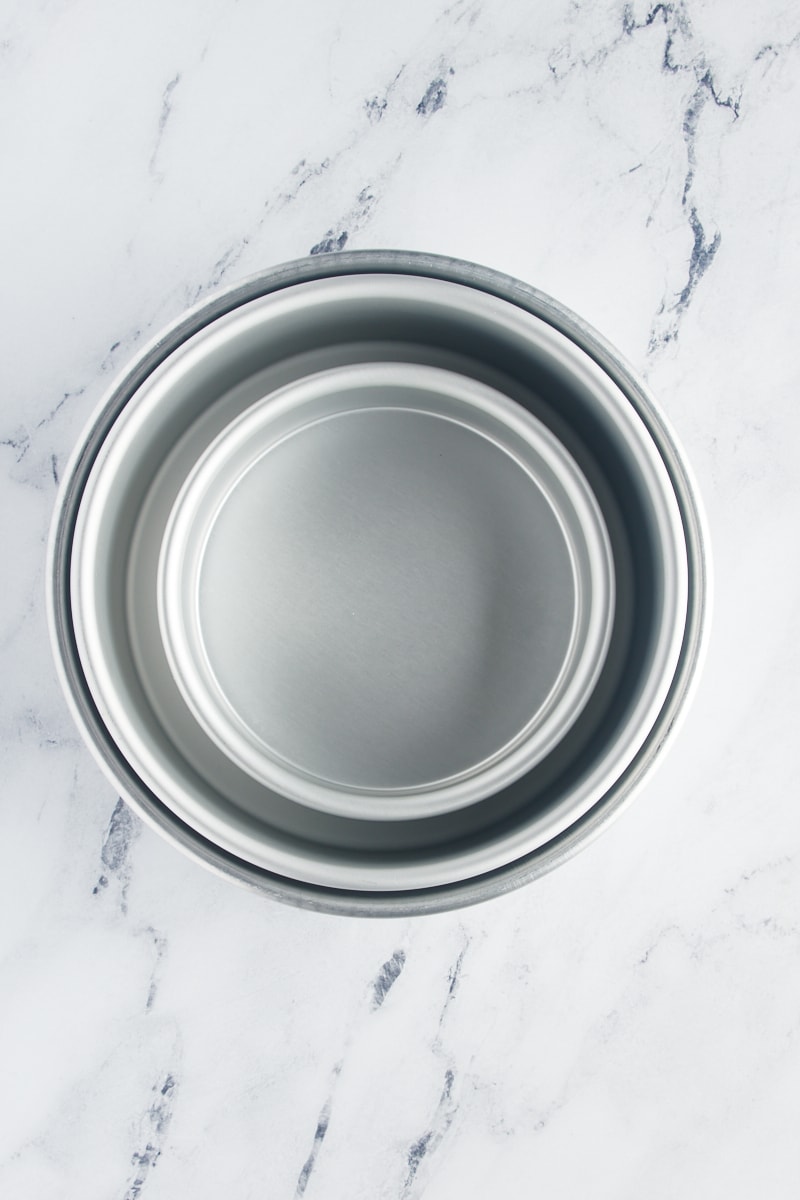
Round Pan Sizes
We most often use round baking pans for baking cakes. In fact, some bakers simply refer to these as cake pans or round cake pans. They’re also useful for other baked goods like cobblers and bread puddings, too. These are the baking pan sizes you’ll most often use.
| Round Pan Dimensions | Capacity |
|---|---|
| 6″ x 2″ | 4 cups |
| 8″ x 1.5″ | 4 cups |
| 8″ x 2″ | 6 cups |
| 9″ x 1.5″ | 6 cups |
| 9″ x 2″ | 8 cups |
| 10″ x 2″ | 11 cups |

Springform Pan Sizes
Springform pans are a must-have for baking cheesecakes. They’re also handy for delicate cakes and other baked goods that will benefit from being able to remove the sides of the pan.
Small springform pans come in varying sizes, so double check your pan’s measurements before making any conversions.
| Springform Pan Dimensions | Capacity |
|---|---|
| 4″ x 2″ | 3 cups |
| 6″ x 3″ | 5 cups |
| 9″ x 2.5″ | 10 cups |
| 9″ x 3″ | 12 cups |
| 10″ x 2″ | 12 cups |

Bundt Pan Sizes
Due to their varying designs, Bundt pans’ capacities can vary. Many Bundt pans are labeled by their volume capacity. If you’re not sure of your pan’s capacity, simply measure the amount of water it will hold.
Mini Bundt pans and Bundtlette pans have dimensions that can vary quite a bit between brands and specific pans. I’ve listed those pans here as a general reference, but I recommend checking your pan’s capacity before using it.
| Bundt Pan Dimensions | Capacity |
|---|---|
| 9″ x 3″ | 7 to 9 cups |
| 10″ x 3.5″ | 10 to 12 cups |
| Bundtlette | 1 cup |
| Mini Bundt | 1/3 cup |
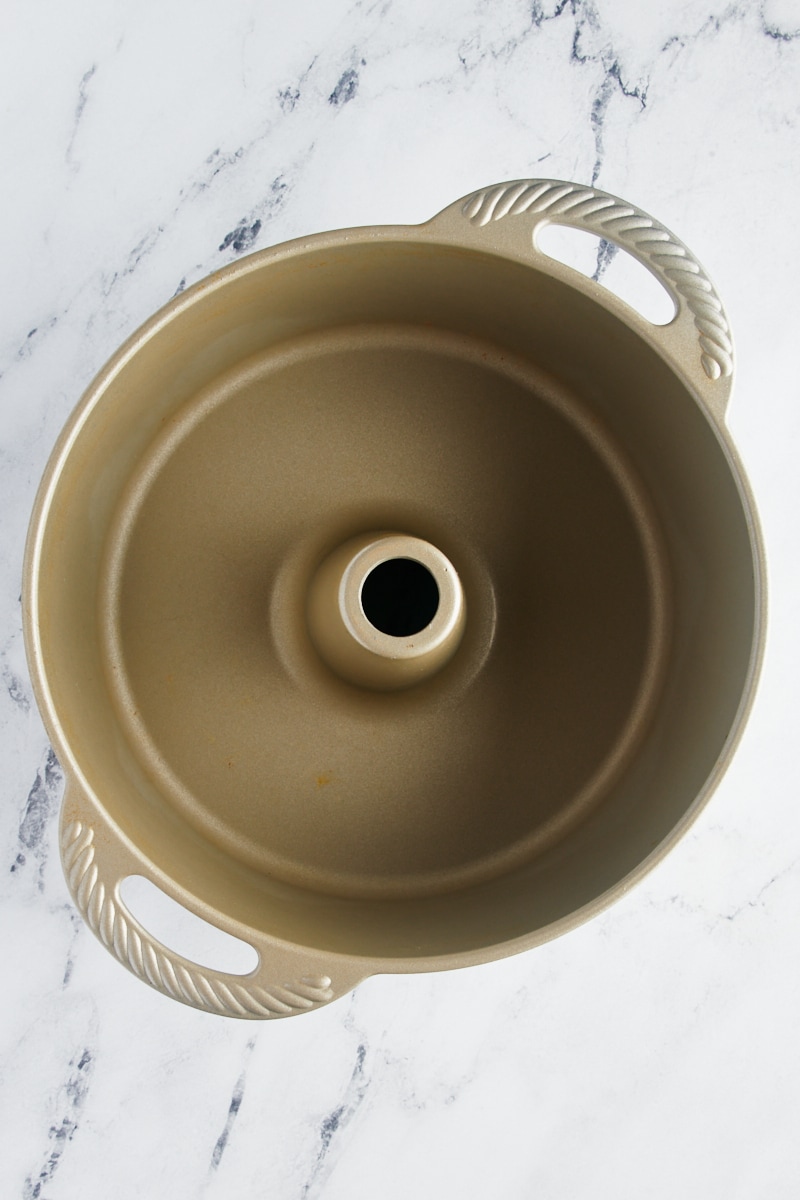
Tube Pan Sizes
Technically, Bundt pans are tube pans, but bakers tend to think of them as their own category of pans. Unlike Bundt pans, tube pans have smooth sides and a flat bottom. They also sometimes come in two pieces with a detachable bottom. These pans are used for delicate cakes like angel food cake. In fact, you may see them referred to as angel food cake pans.
| Tube Pan Dimensions | Capacity |
|---|---|
| 8″ x 3″ | 9 cups |
| 9″ x 3″ | 12 cups |
| 10″ x 3″ | 16 cups |
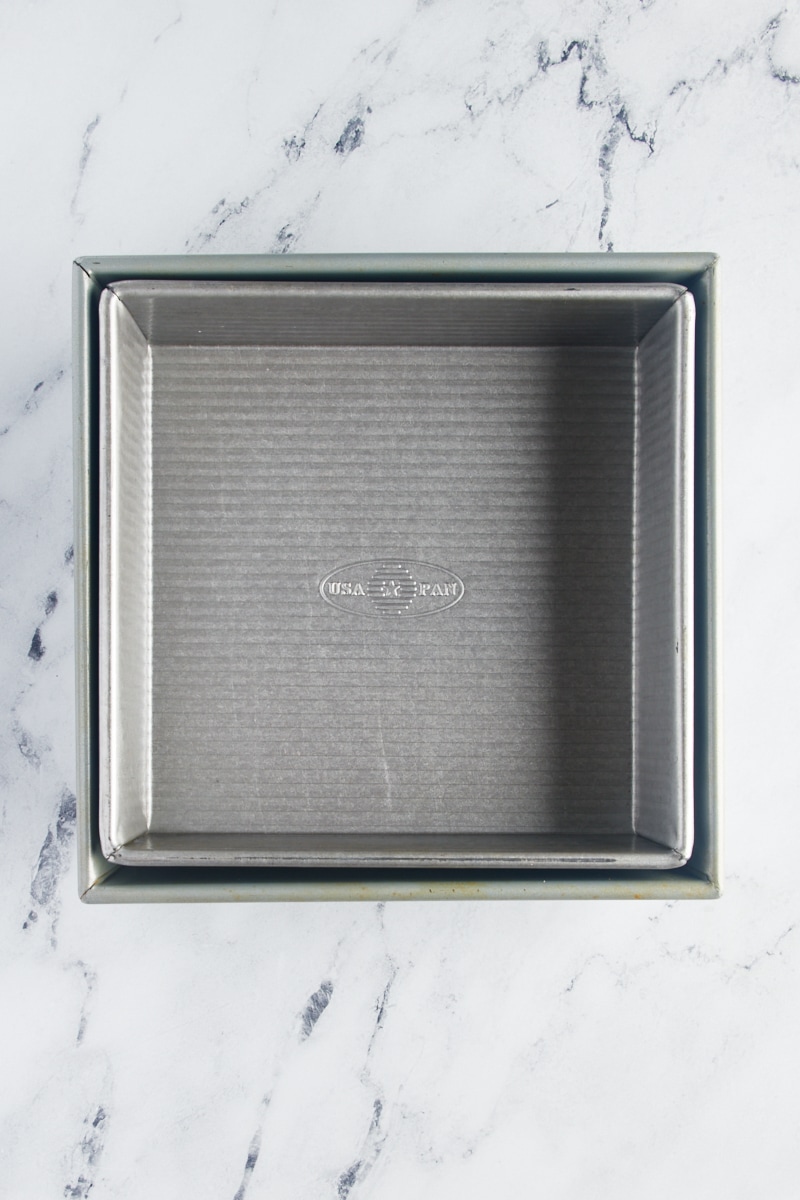
Square Pan Sizes
Square baking pans are a great size for homemade brownies, among other favorites. It’s worth noting how the volume can vary with the depth of the pans. I generally recommend a 2-inch depth for these pans.
| Square Pan Dimensions | Capacity |
|---|---|
| 8″ x 8″ x 1.5″ | 6 cups |
| 8″ x 8″ x 2″ | 8 cups |
| 9″ x 9″ x 1.5″ | 8 cups |
| 9″ x 9″ x 2″ | 10 cups |
| 10″ x 10″ x 2″ | 12 cups |
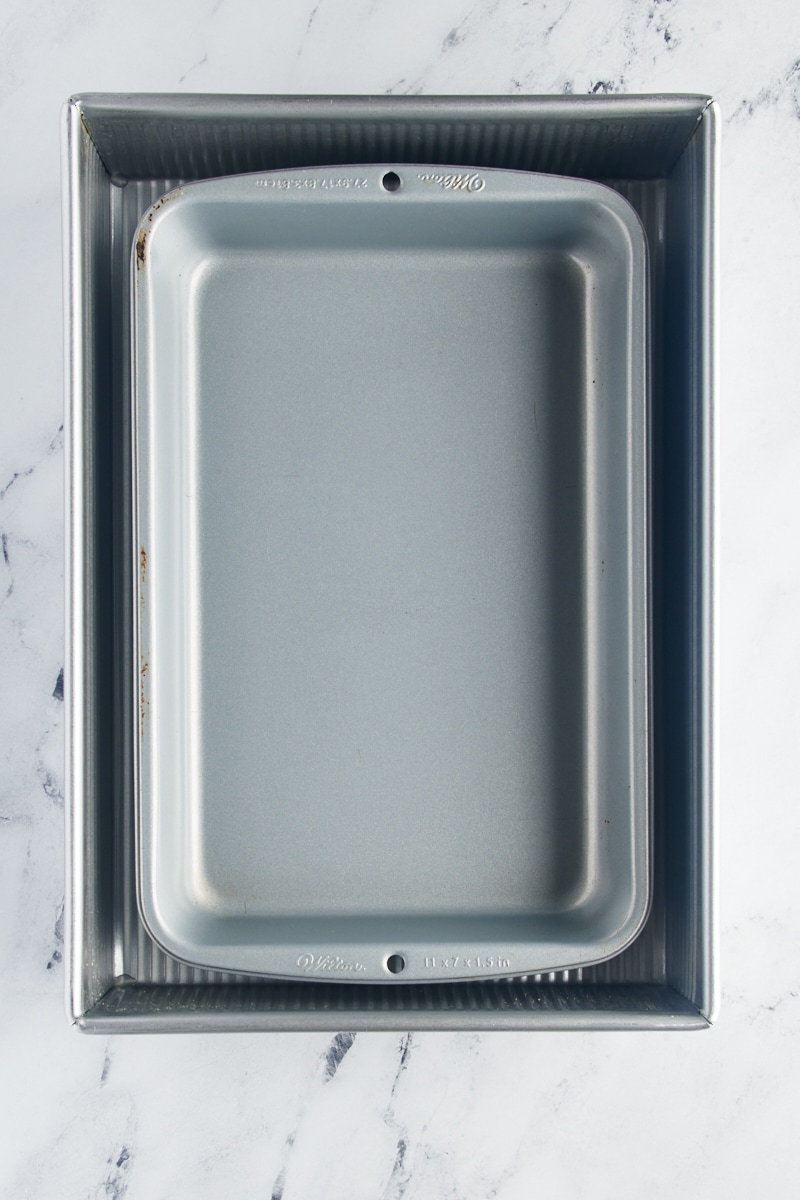
Rectangular Pan Sizes
For many home bakers, rectangular pans (especially 9″ x 13″ pans) get used quite a bit. Cakes, brownies, bars, and more can all be baked in these pans.
| Rectangular Pan Dimensions | Capacity |
|---|---|
| 11″ x 7″ x 2″ | 10 cups |
| 13″ x 9″ x 2″ | 15 cups |

Loaf Pan Sizes
Loaf pans are great for making loaves of bread, but they’re also great for small cakes, too. Unfortunately, a pan labeled as a “standard” loaf pan can have either 6 or 8 cups capacity. Be sure to measure your pan if you’re not sure which size you have.
Mini loaf pans can vary quite a bit in dimensions and capacity. I’ve listed a common size here for reference, but be sure to measure yours before baking.
| Loaf Pan Dimensions | Capacity |
|---|---|
| 8.5″ x 4.5″ x 2.5″ | 6 cups |
| 9″ x 5″ x 3″ | 8 cups |
| 5.75″ x 3″ (mini) | 2 cups |
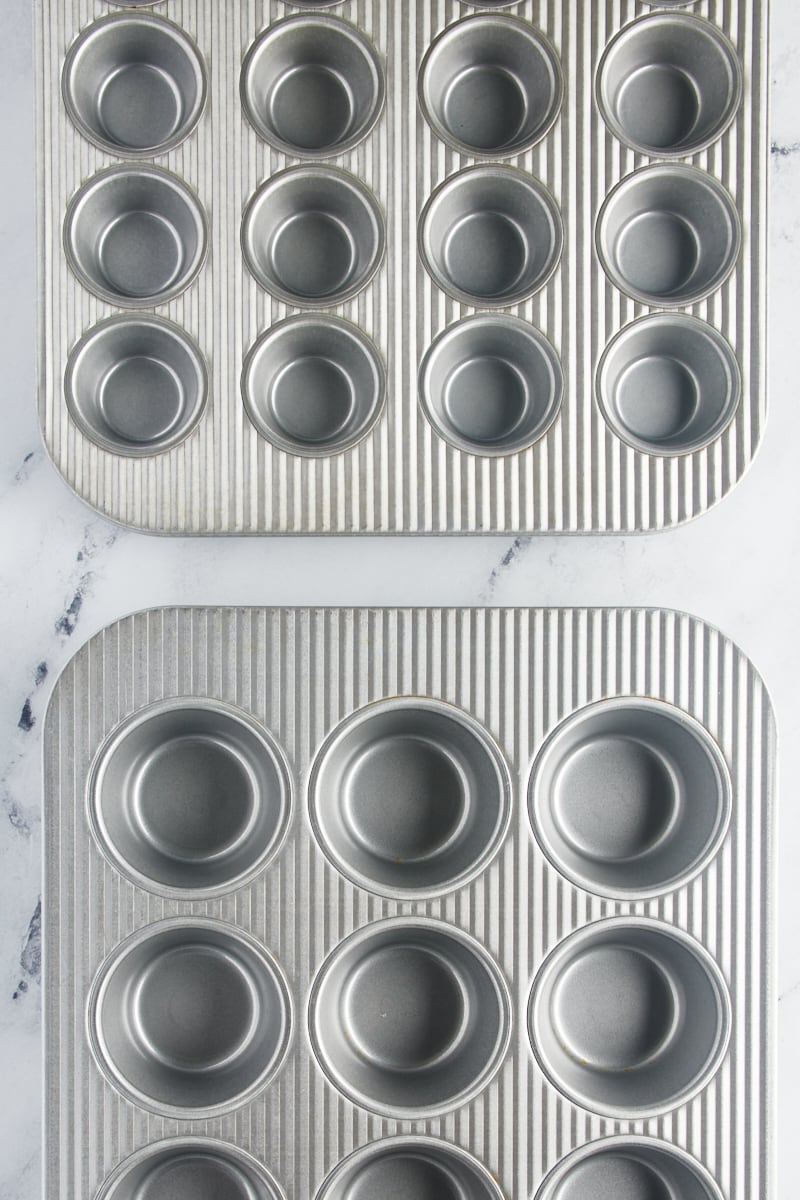
Muffin Pan Sizes
If you’re a fan of muffins and cupcakes, then you’ve likely got at least one muffin pan in your kitchen. Generally, these pans are consistently sized, but there are always exceptions. These are the standard dimensions and capacities of most muffin pans.
| Muffin Pan Dimensions | Capacity |
|---|---|
| 1.75″ x 0.75″ (mini) | 1/8 cup |
| 2.75″ x 1.125″ (standard) | 1/4 cup |
| 3″ x 1.25″ (jumbo) | 5/8 cup |

Sheet Pan Sizes
Sheet pans are often used for baking cookies or other baked goods where the pan’s volume capacity isn’t much of an issue. However, they are also used for sheet cakes, bars, brownies, and more. These are common sheet pans and jelly roll pans that you’re likely to come across in baking recipes.
| Sheet Pan Dimensions | Capacity |
|---|---|
| 9″ x 13″ x 1″ (quarter sheet) | 7 cups |
| 18″ x 13″ x 1″ (half sheet) | 14 cups |
| 10.5″ x 15.5″ x 1″ (jelly roll) | 10 cups |
| 12.5″ x 17.5″ x 1″ (jelly roll) | 12 cups |
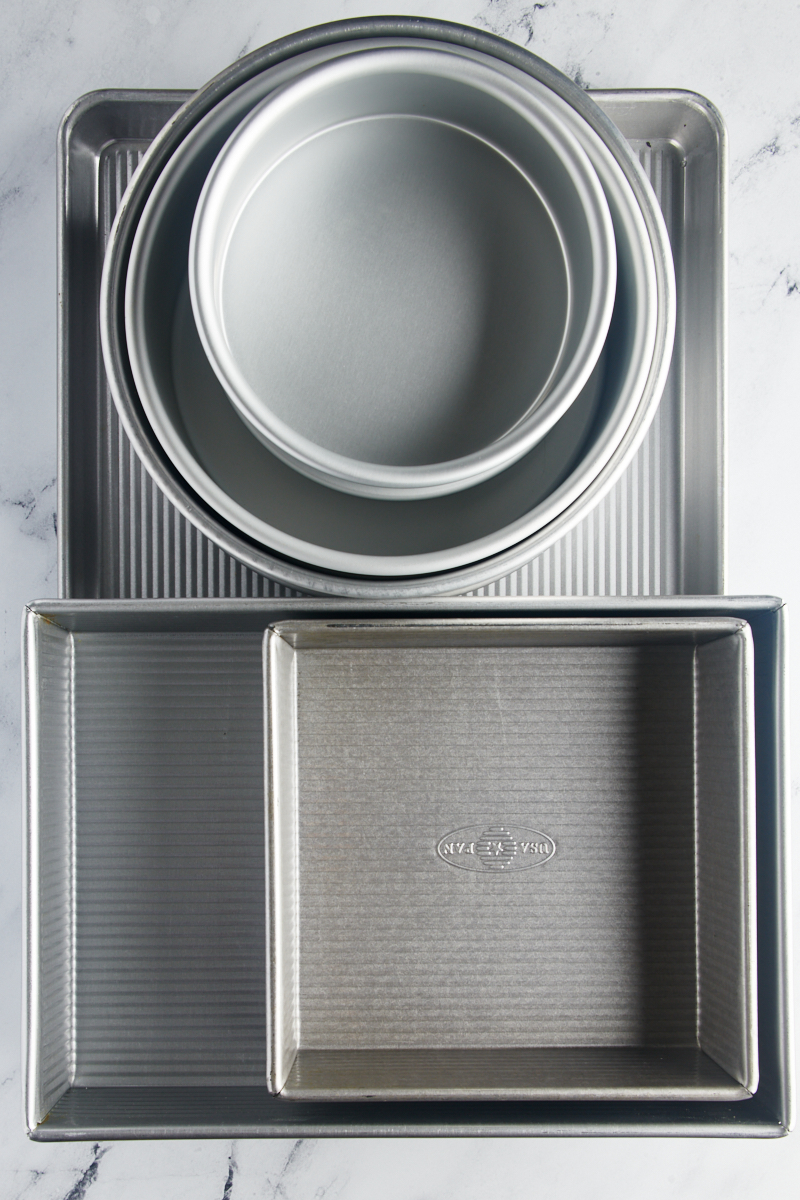
More About Baking Pans
Now that you’ve learned all about baking pan sizes and volumes, are you ready to learn even more? Here’s some more info I hope you’ll find useful.
And you can find many of my favorite baking pans in my Amazon storefront.
Bake or Break is a participant in the Amazon Services LLC Associates Program, an affiliate advertising program designed to provide a means for us to earn fees by linking to Amazon.com and affiliated sites.





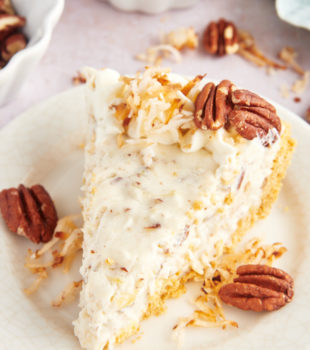

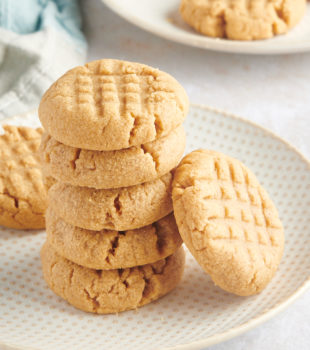


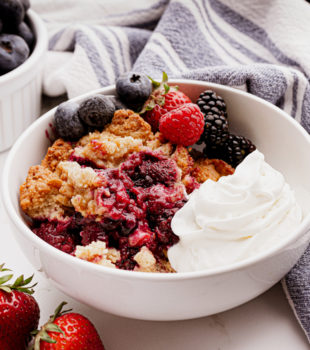
6 Comments on “Baking Pan Sizes and Capacities”
Hello. My recipe calls for 9 inch pans. I only have 8 inch pans. What should I do?
Hello! It depends on the recipe, but you have some options. Depending on how much batter you have, you might be able to use the full amount and bake it a bit longer. The outside edges may be more baked than the center, and you’d need to be careful not to over-fill so you don’t end up with a mess. You could also use less batter in your 8-inch pans and either discard the remainder or bake what’s left in a small pan like a muffin pan. Take a look at the pan size charts above that show the volume capacity of different sized pans; that should let you estimate how much batter to leave out to accommodate the smaller size.
Regarding Bundt pans being difficult to substitute for, I find making half the recipe in a suitable loaf pan (not too short and wide) often works well. The long “brick” you get from the loaf pan is similar enough in thickness to the “donut” running around the Bundt pan that the baking properties are similar.
Yes, this is a great way to half a Bundt cake recipe in many cases!
Thank you! Thank you! Thank you! I’ve been looking everywhere trying to find how to calculate the volume in cups of my pans, and the areas. Everyplace just has charts and the search engines are really loathe to include results with the all important word – “calculate.” “Math? Surely no one wants to do math! ” they seem to be saying. But math is the only way to know the area and volume in cups of any pan, whether or not the pan you’re thinking of is a common enough size to appear in the endless (and always limited) conversion charts that are all over the internet. You have empowered me to figure out which of my wonky pans most closely converts to the sizes listed in récipes. My hearo! Thank you 🙂
I’m so glad you found this helpful, Elizabeth! I’ve always loved math, so I don’t shy away from it. 🙂 Happy baking!